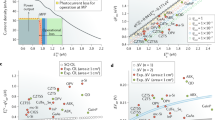Abstract
The extraordinary advancement in photovoltaic (PV) technologies over the last 5 years requires a renewed evaluation of their performance and prospective progress in the future. We analyze here comparing PV cell properties across technologies, we evaluate the extent to which any technology can move in the near future. Although accurate or revolutionary advancements cannot be foreseen, cross-fertilization happens between technologies and results in one cell type indicate evolutionary developments in other cells. This transfer of knowledge is crucial since the development of metal halide perovskites helps to connect the hitherto separate technological strands of photovoltaic research.
Access this chapter
Tax calculation will be finalised at checkout
Purchases are for personal use only
Similar content being viewed by others
References
http://www.energybc.ca/ (2005) [Online]. Available: http://www.energybc.ca/cache/solarpv/www.cetonline.org/Renewables/PV_pro_con.html
“Planete Engergies,” (2010) [Online]. Available: https://www.planete-energies.com/en/medias/close/how-does-photovoltaic-cell-work. [Accessed 2021]
Cubas JPSMC (2014) Explicit expressions for solar panel equivalent circuit parameters based on analytical formulation and Lambert W-function
Izawa S, Perrot A, Lee J-H, Hiramoto M (2019) Organic PN homojunction solar cell. Org Electron 45–49
MB, Hansen C Single diode equivalent circuit model. PV performance modeling collaborative
Khan B Non conventional energy resources. McGraw Hill Education Pvt. Ltd., Chennai
AD, Rajapakse MD (2009) Simulation tools for photovoltaic system grid integration studies. In: IEEE Electrical power & energy conference (EPEC)
JWXMJGCXXWXZZWF, Zhenghao Hu Z, Semitransparent organic solar cells exhibiting 13.02% efficiency and 20.2% average visible transmittance. J Mater Chem
SPALJ-H, Izawa HM (2019) Organic PN homojunction solar cell. Org Electron
Rooij DD, sinovoltaics [Online]. Available: https://sinovoltaics.com/learning-center/solar-cells/amorphous-silicon-solar-cells-structure-and-applications/
Jestin Y (2012) Down Shifting of incident light for photovoltaic applications. Compressive Renew Energy 563–585
Larson B, NREL transforming energy [Online]. Available: https://www.nrel.gov/pv/organic-photovoltaic-solar-cells.html
M, Sidrach-de-Cardona MLL (1998) A simple model for sizing stand alone photovoltaic systems. Solar Energy Mater Solar Cells, 199–214
Wai R-J, Wang W-H, Lin C-Y (2008) High-Performance Stand-Alone Photovoltaic Generation System. IEEE Trans Ind Electron 240–250
Jakhar S, Soni MS, Gakkhar N (2017) Modelling and simulation of concentrating photovoltaic system with Earth water heat exchanger cooling. Energy Procedia 78–85
Green MA (2011) Radiative efficiency of state-of-the-art photovoltaic cells. Prog Photovoltaics: Res Appl 472–476
M, Abdolzadeh AM (2009) Improving the effectiveness of a photovoltaic water pumping system by spraying water over the front of photovoltaic cells. Renew Energy 91–96
VLGYYCC-W, Shrotriya YY (2006) Transition metal oxides as the buffer layer for polymer photovoltaic cells. Appl Phys Lett
Sambur JB, Novet T, Parkinson BA (2010) Multiple exciton collection in a sensitized photovoltaic system. Science 63–66
HMTVAGDMMJSWA, Águas MR (2015) Thin film silicon photovoltaic cells on paper for flexible indoor applications. Adv Funct Mater 3592–3598
SA, Jenekhe YS (2000) Efficient photovoltaic cells from semiconducting polymer heterojunctions. Appl Phys Lett 2635–2637
CSSR, Goh MMD (2007) Effects of molecular interface modification in hybrid organic-inorganic photovoltaic cells. J Appl Phys
BA, Gregg HMC (2003) Comparing organic to inorganic photovoltaic cells: theory, experiment, and simulation. J Appl Phys 3605–3614
Blakers A, Zin N, McIntosh KR, Fong K (2013) High efficiency silicon solar cells. Energy Procedia. 1–10
RMMKT, Chenni BA (2007) A detailed modeling method for photovoltaic cells. Energy 1724–1730
Hua C, Lin J, Shen C (1998) Implementation of a DSP-controlled photovoltaic system with peak power tracking. IEEE Trans Ind Electron 99–107
Park M, Yu I-K (2004) A novel real-time simulation technique of photovoltaic generation systems using RTDS. IEEE Trans Energy Convers, 164–169
Chai JY-H, Wong BT, Juodkazis S (2020) Black-silicon-assisted photovoltaic cells for better conversion efficiencies: a review on recent research and development efforts. Mater Today Energy 18
Boutouchent-Guerfi N, Boussourdi MA, Lami A, Ould-Hamou M, Drouiche N (2021) Dry magnetic separation on the recovery of metal fragments from Kerf Slurry waste produced during the manufacture of photovoltaic solar cells. Silicon 149–153
H-CWRZYZSDZL, Cheng P (2020) Enabling high-performance Tandem organic photovoltaic cells by balancing the front and rear subcells. Adv Mater
Karakawa M, Suzuki K, Kuwabara T, Taima T, Nagai K, Nakano M, Yamaguchi T, Takahashi K (2020) Factors contributing to degradation of organic photovoltaic cells. Org Electron 76
Author information
Authors and Affiliations
Corresponding author
Editor information
Editors and Affiliations
Rights and permissions
Copyright information
© 2023 The Author(s), under exclusive license to Springer Nature Singapore Pte Ltd.
About this paper
Cite this paper
Prajapati, T., Priyam, A. (2023). A Review on Photovoltaic Cells. In: Namrata, K., Priyadarshi, N., Bansal, R.C., Kumar, J. (eds) Smart Energy and Advancement in Power Technologies. Lecture Notes in Electrical Engineering, vol 926. Springer, Singapore. https://doi.org/10.1007/978-981-19-4971-5_36
Download citation
DOI: https://doi.org/10.1007/978-981-19-4971-5_36
Published:
Publisher Name: Springer, Singapore
Print ISBN: 978-981-19-4970-8
Online ISBN: 978-981-19-4971-5
eBook Packages: EnergyEnergy (R0)




